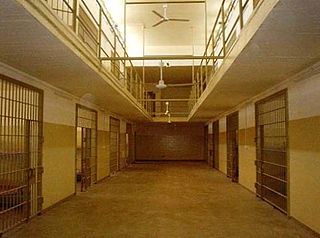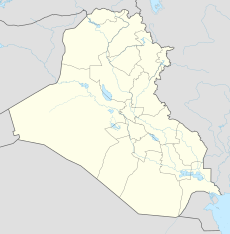
The Gulf War was an armed campaign waged by a United States-led coalition of 35 countries against Iraq in response to the Iraqi invasion and annexation of Kuwait.
This is a timeline of the events surrounding the United States-led invasion of Iraq in 2003.

The 2003 invasion of Iraq was the first stage of the Iraq War. The invasion phase began on 19 March 2003 (air) and 20 March 2003 (ground) and lasted just over one month, including 26 days of major combat operations, in which a combined force of troops from the United States, the United Kingdom, Australia and Poland invaded Iraq. 22 days after the first day of the invasion, the capital city of Baghdad was captured by Coalition forces on 9 April 2003 after the six day long Battle of Baghdad. This early stage of the war formally ended on 1 May 2003 when U.S. President George W. Bush declared the "end of major combat operations" in his Mission Accomplished speech, after which the Coalition Provisional Authority (CPA) was established as the first of several successive transitional governments leading up to the first Iraqi parliamentary election in January 2005. U.S. military forces later remained in Iraq until the withdrawal in 2011.

The occupation of Iraq is characterized by a large United States military deployment on Iraqi territory, beginning with the U.S.-led invasion of the country in March 2003 which overthrew the Ba'ath Party government of Saddam Hussein and ending with the departure of US troops from the country in 2011. Troops for the invasion came primarily from the United States, the United Kingdom and Australia, but 29 other nations also provided some troops, and there were varying levels of assistance from Japan and other countries.
This is a list of aviation-related events from 1991:

Abu Ghraib prison was a prison complex in Abu Ghraib, Iraq, located 32 kilometers (20 mi) west of Baghdad. Abu Ghraib prison was opened in the 1950s and served as a maximum-security prison with torture, weekly executions, and squalid living conditions. From the 1970s, the prison was used by Saddam Hussein and later the United States to hold political prisoners. It developed a reputation for torture and extrajudicial killing, and was closed in 2014.
The following lists events in the year 2003 in Iraq.
Events in the year 2002 in Iraq.

Task Force 20 is a temporary combat force designation that has been used several times and may still used by separate parts of the United States armed forces. The longer-established iteration was a part of the United States Second Fleet in the Atlantic from after the Second World War. This was part of the formal United States Military Communications-Electronic Board system.

The Iraqi Armed Forces are the military forces of the Republic of Iraq. They consist of the Iraqi Army, the Iraqi Air Force, and the Iraqi Navy. Along with these three primary service branches, there exists the Iraqi Special Operations Forces. The President of Iraq acts as the supreme commander of the military as outlined by the national constitution.

The Battle of the Karbala Gap occurred during the 2003 invasion of Iraq. The Karbala Gap is a 20–25-mile wide strip of land with the Euphrates River to the east and Lake Razazah to the west. This strip of land was recognized by Iraqi commanders as a key approach to Baghdad, and was defended by the Medina and Nebuchadnezzar Divisions of the Iraqi Republican Guard. American forces attacked Iraqi forces in the area with massive air attacks followed by concentrated armored thrusts which resulted in the Iraqi units being surrounded and annihilated.
Joint Special Operations Command Task Force in the Iraq War was a joint American and British special operations unit, of which little is publicly known. It is described as a "hunter-killer team" with its core made up of the United States Army's 1st Special Forces Operational Detachment-Delta and the 75th Ranger Regiment, as well as the United States Naval Special Warfare Development Group and members of the United States Air Force's 24th Special Tactics Squadron, all under Joint Special Operations Command (JSOC) and elements from the United Kingdom Special Forces, including the Special Air Service, Special Boat Service (SBS), Special Reconnaissance Regiment (SRR), 18 (UKSF) Signal Regiment and the Special Forces Support Group (SFSG). The unit was reported to be responsible for the cross border raid into Syria from Iraq in October 2008 that resulted in eight deaths including Abu Ghadiya, along with several US operations in the Horn of Africa targeting al Qaeda.

Saddam Hussein (1937–2006) initiated an extensive biological weapons (BW) program in Iraq in the early 1980s, despite having signed the Biological Weapons Convention (BWC) of 1972. Details of the BW program—along with a chemical weapons program—surfaced only in the wake of the Gulf War (1990–91) following investigations conducted by the United Nations Special Commission (UNSCOM) which had been charged with the post-war disarmament of Saddam's Iraq. By the end of the war, program scientists had investigated the BW potential of five bacterial strains, one fungal strain, five types of virus, and four toxins. Of these, three—anthrax, botulinum and aflatoxin—had proceeded to weaponization for deployment. Because of the UN disarmament program that followed the war, more is known today about the once-secret bioweapons program in Iraq than that of any other nation.

The lead-up to the Iraq War began with United Nations Security Council Resolution 687 and subsequent UN weapons inspectors inside Iraq. This period also saw low-level hostilities between Iraq and the United States-led coalition from 1991–2003.

The air campaign of the Gulf War, also known as the 1991 bombing of Iraq, was an extensive aerial bombing campaign from 17 January 1991 to 23 February 1991. The Coalition of the Gulf War flew over 100,000 sorties, dropping 88,500 tons of bombs, widely destroying military and civilian infrastructure. The air campaign was commanded by USAF Lieutenant General Chuck Horner, who briefly served as Commander-in-Chief—Forward of U.S. Central Command while General Schwarzkopf was still in the United States. The British air commanders were Air Vice-Marshal Andrew Wilson and Air Vice-Marshal Bill Wratten. The air campaign had largely finished by 23 February 1991 when the coalition invasion of Kuwait took place.
Qayyarah Airfield West is an Iraqi Air Force base in the Qayyarah subdistrict of Mosul District in northern Iraq. It was captured by U.S. Army during Operation Iraqi Freedom in 2003. It was also known as Q–West or Key West by the various U.S. Army Forces and civilian contractors stationed there. Control of the base was returned to Iraq in March 2020.
Muthenna Air Base is a former Iraqi Air Force base in the Baghdad Governorate of Iraq. It was captured by U.S.-led Coalition forces during Operation Iraqi Freedom in 2003.
This is a timeline of events during the War in Iraq in 2015.
A suicide car bombing occurred on 17 July 2015 in the Iraqi city of Khan Bani Saad, targeting a local marketplace. As of 19 July 2015 approximately 130 people were killed in the bombing, with a similar number of injured. Several people were killed by collapsed buildings. The bomb was hidden under an ice truck in an attempt to attract more people amid the heat. Responsibility for the attack was claimed by the Islamic State of Iraq and the Levant (ISIL).









